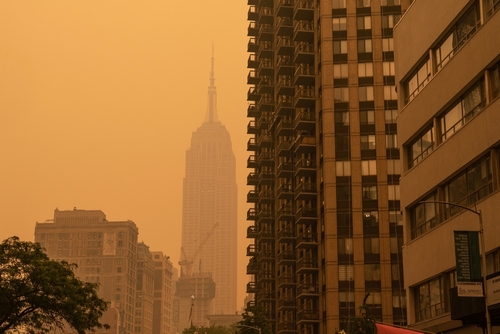The recent Canadian wildfires greatly impacted air quality hundreds of miles away in major American cities, demonstrating how disasters in one country can affect the health of others. This issue also came to light in the last several years as the airborne COVID-19 virus forced people to wear masks and stay indoors, where their health was dependent on the air quality of buildings and facilities.

On June 7, smoke from the Canadian wildfires turned the New York City skyline a hazy orange, and officials across several states issued air quality warnings.
In May, the Centers for Disease Control and Prevention (CDC) established new ventilation guidelines that recommended all buildings have MERV-13 air filters, use built-in high-efficiency particulate air (HEPA) fan/filtration systems, and get at least 5 air changes per hour of clean air in occupied spaces. It also emphasized post-occupancy flushing of building air and offered additional information on maintenance and energy cost considerations. While this emphasized the need to change building practices, it highlighted the potential exacerbated health dangers if these guidelines are ignored.
Even beyond climate and health crises, particle pollution in our atmosphere affects the air we breathe. Last year, about 66 million tons of pollution were emitted into the atmosphere in the United States alone. To guarantee occupants are safe, building owners must invest in air quality as a part of their safety and sustainability initiatives moving forward.
More than 1 in 3 Americans live in places with unhealthy levels of air pollution. Gasses and fine particles (PM2.5) from environmental damage and air pollution lead to negative health effects and outcomes, including from coughing and pulmonary inflammation. Some studies have suggested that PM2.5 is potentially more toxic than equal doses of other particles, such as ambient pollution. High concentrations of harmful pollutants from uncontainable contaminants can infiltrate indoors through poor filtration systems, infrastructure, and maintenance, where they risk causing further harm.
Being able to monitor a building’s level of airborne pollutants and PM2.5 to mitigate the effects of outdoor pollution from extreme weather conditions is crucial. The particles and gases included in PM2.5 found in wildfire smoke, including ammonia (NH3), nitrogen dioxide (NO2), sulfur dioxide (SO2), and non-methane volatile organic compounds (NMVOCs), can make their way into schools, office buildings, and other facilities if they are not properly maintained and ventilated.
However, the slow digitization of older buildings’ HVAC systems and inconsistent routine inspections have left the maintenance of breathing environments solely on building owners and operators. We need better visibility into indoor air quality (IAQ) conditions, and real-time monitoring devices are a crucial element of this process.
During the outbreak of the pandemic, many monitoring and ventilation systems addressed these needs. These technologies helped underperforming buildings diagnose the health of space. For example, IAQ monitoring sensors were installed in over 1,000 schools nationwide, including Denver Public Schools, to help improve safety and minimize the risk of infectious diseases.
The Biden-Harris Administration’s Clean Air in Building Challenge and other initiatives created to slow the spread of COVID-19 have increased awareness and popularity of these real-time monitoring systems in public schools, offices, and other commercial buildings. Yet, since the end of the pandemic, many institutions have failed to follow through with promoting further legislation of clean air quality efforts. The Public Health Air Quality Act of 2022 and the Better Data for Cleaner Air Act of 2022 by Congress were introduced, with minimal moves since December of last year.
Building owners and operators must incorporate the updated CDC recommendations with detection tools that provide insight into current breathing conditions to mitigate and monitor IAQ in real time. The recent Canadian wildfires and pandemic shed light on the dangers of indoor-outdoor pollution; the progress towards bettering air quality conditions has to start with sustainable devices to mitigate its effects on inhabitants.
All people deserve to breathe clean air. With the intensity and frequency of environmental disasters, people’s health and livelihoods are on the line. With wildfire smoke, viruses, or other airborne pollutants evident, air pollution has made breathing conditions an issue of public health. Though we can’t always prevent crises that add pollution to our environment, be they pandemics or wildfires, we can prioritize programs that monitor and mitigate its effects today—so that all citizens can breathe easier.
Dr. Serene Almomen is the co-founder and CEO of smart building technology company Attune.
Editor’s note: The views expressed in this article are the author’s and do not necessarily reflect those of Facilities Management Advisor. To learn more about creating safe indoor environments, make sure to participate in FMA’s upcoming Healthy Buildings Week 2023! Details and FREE webinar registration are available here.
The post The CDC Ventilation Update Couldn’t Have Come Sooner: Real-Time Monitoring Is Needed Now appeared first on Facilities Management Advisor.








0 Comments